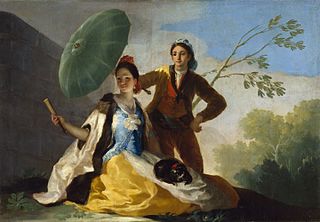
The Parasol is one of a cartoon series of oil on linen paintings made by the painter Francisco Goya. This series of paintings was specifically made in order to be transformed into tapestries that would be hung on the walls of the Royal Palace of El Pardo in Madrid, Spain. The tapestries showed serene events in everyday life, which made them a nice addition to the dining room of Prince and Princess of Asturias—the future King Charles IV and Maria Luisa of Parma. The queen called on Goya because she wanted to decorate the dining room with cheerful scenes; The Parasol and the other tapestry paintings were Goya's response to this request. The painting is currently located in the Museo del Prado in Madrid as is another in the series, Blind man's bluff.
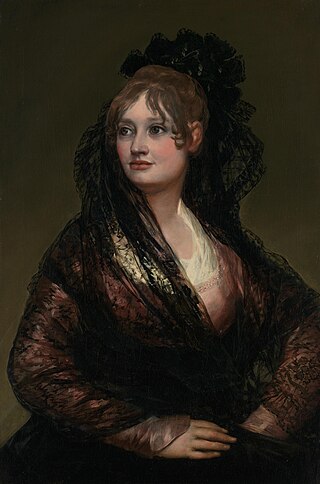
The Portrait of Doña Isabel de Porcel is an oil-on-canvas painting by the Spanish artist Francisco de Goya, painted around 1805. The portrait depicts Isabel Lobo Velasco de Porcel, who was born at Ronda around 1780 and was the second wife of Antonio Porcel. Isabel's husband was 25 years older than she; they met when she was 20 years old. Antonio Porcel was a liberal and associate of Manuel Godoy, Prince of Peace, who was a friend of Gaspar Melchor de Jovellanos, who in turn brought him in contact with Goya, who lived nearby; the painting is said to have been a gift from the artist in return for hospitality. A Goya portrait of Antonio Porcel, though much larger and so not a matching piece, was lost in a fire when the Jockey Club in Buenos Aires was destroyed in a riot in 1953.

Atropos, or The Fates is one of the 14 Black Paintings painted by Francisco de Goya between 1819–1823. Goya, then 75 and in mental and physical despair, created the series directly onto the interior walls of the house known as the Quinta del Sordo, purchased in 1819.

Judith and Holofernes is the name given to one of the 14 Black Paintings painted by Francisco de Goya between 1819 and 1823. By this time, Goya was in his mid 70s and deeply disillusioned. In mental and physical despair, he painted the private works on the interior walls of his home—applying oils directly on plaster—known as the Quinta del Sordo, which he had purchased in 1819. Judith and Holofernes was likely painted on the first floor, beside Saturn Devouring His Son. The picture is a personal reinterpretation of the narrative of the Book of Judith, in which the protagonist saves Israel from the assault of the general Holofernes by seducing and beheading him. Judith is the only historical figure who can be identified with certainty among the Black Paintings.

A Pilgrimage to San Isidro is one of the Black Paintings painted by Francisco de Goya between 1819–23 on the interior walls of the house known as Quinta del Sordo that he purchased in 1819. It probably occupied a wall on the first floor of the house, opposite The Great He-Goat.

The Inquisition Tribunal, also known as The Court of the Inquisition or The Inquisition Scene, is a 46-by-73-centimetre oil-on-panel painting produced by the Spanish artist Francisco Goya between 1812 and 1819. The painting belongs to a series which also includes Bullfight, The Madhouse and A Procession of Flagellants, all reflecting customs which liberals objected to and wished were abandoned, but their reform was opposed by the absolutist (autocratic) policy of Ferdinand VII of Spain.

A Procession of Flagellants is an oil-on-panel painting produced by Francisco de Goya between 1812 and 1819. In the foreground is a procession of Roman Catholic men dressed in white, wearing pointed hats and whipping their bared backs in penitence. Their backs are bleeding and they pull over-life-size statues of Nuestra Señora dela Soledad, the Ecce Homo and the Crucifixion of Christ. Other devotees, who are kneeling and wearing black hoods, line the route. On the right a man is impaled and all are carrying banners, crosses and lamps.

The Adoration of the Name of God or The Glory (1772) is a fresco painted by Francisco Goya on the ceiling of the cupola over the Small Choir of the Virgin in the Basílica de Nuestra Señora del Pilar in Zaragoza.
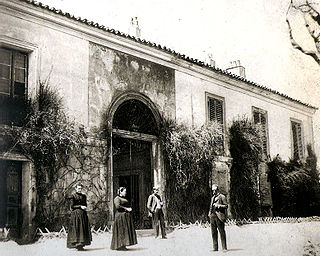
The Black Paintings is the name given to a group of 14 paintings by Francisco Goya from the later years of his life, likely between 1819 and 1823. They portray intense, haunting themes, reflective of both his fear of insanity and his bleak outlook on humanity. In 1819, at the age of 72, Goya moved into a two-story house outside Madrid that was called Quinta del Sordo. Although the house had been named after the previous owner, who was deaf, Goya too was nearly deaf at the time as a result of an unknown illness he had suffered when he was 46. The paintings originally were painted as murals on the walls of the house, later being "hacked off" the walls and attached to canvas by owner Baron Frédéric Émile d'Erlanger. They are now in the Museo del Prado in Madrid.

Allegory of Industry is a tondo painted by Francisco de Goya which was one of the four paintings from a series of allegories about scientific and economic progress, which decorated a waiting room of the residence of Manuel Godoy, Prime Minister of Spain during the reign of Charles IV. Since 1932, the picture has been in the Museo del Prado. The image shows two young women as they thread their respective spinning wheels in a semi-darkened room, illuminated by a large window which opens from the left. At the back, in the dark, one can discern uncertain faces of old women. The uncertainty of these women doesn’t reveal whether or not they are factor workers or representations of the tapestry or canvas.

Portrait of Manuel Godoy is a large 1801 oil-on-canvas painting by the Spanish artist Francisco de Goya, now in the Real Academia de Bellas Artes de San Fernando. It was commissioned by the Spanish Prime Minister Manuel Godoy to commemorate his victory in the brief War of the Oranges against Portugal.

Portrait of Ferdinand Guillemardet is an oil painting by Francisco Goya, from 1798-1799. It depicts Ferdinand Guillemardet (1765-1809), the French ambassador to Spain between 1798 and 1800. It is held in the Louvre, in Paris.
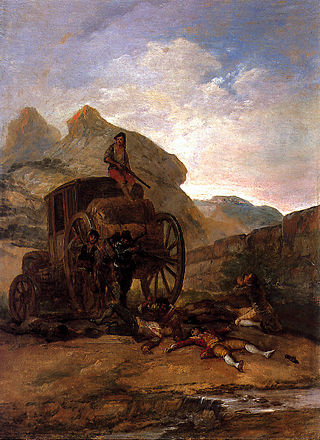
Assault of Thieves is an oil painting made by the Spanish artist Francisco de Goya between 1793 and 1794. It is part of a private collection owned by Juan Abelló.

Children in a Chariot is a 1779 painting by Francisco de Goya. It is part of the third series of cartoons he produced for tapestries at the Royal Palace of El Pardo; the tapestry in question was to be positioned over a door. The painting is in the Toledo Museum of Art, in Toledo, Ohio.

The Drunk Mason is an oil on canvas painted by Francisco de Goya, then reputed painter of tapestries for the royal palaces. It belonged to the fifth series undertaken by Goya, and, like all the pieces that compose it, was painted between 1786 and 1787.

The series of paintings for the alameda of the Dukes of Osuna comprises seven pictures painted by Francisco de Goya between 1786 and 1787. The country estate of the dukes and duchesses, who were the painter's mecenas and friends, was known as El Capricho, and was located on the outskirts of Madrid.

The tapestry cartoons of Francisco de Goya are a group of oil on canvas paintings by Francisco de Goya between 1775 and 1792 as designs for the Royal Tapestry Factory of Santa Barbara near Madrid in Spain. Although they are not the only tapestry cartoons made at the Royal Factory, they are much the best known. Most of them represent bucolic, hunting, rural and popular themes. They strictly adhered to the tastes of King Charles III and the princes Charles of Bourbon and Maria Luisa of Parma, and were supervised by other artists of the factory such as Maella and the Bayeu family. Most are now in the Museo del Prado, having remained in the Spanish Royal collection, although there are some in art galleries in other countries.
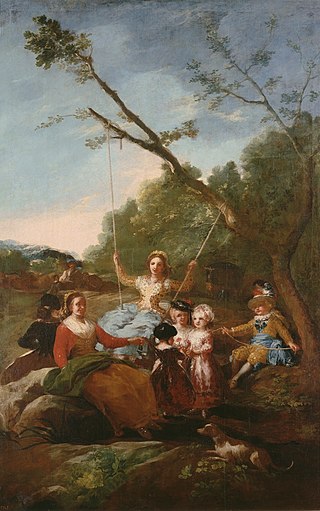
The Swing is the title of a tapestry cartoon designed by Francisco de Goya for the bedroom of the Princes of Asturias in the Palace of El Pardo. It is kept in the Museo del Prado.

La novillada, is an oil painting by Francisco de Goya, painted in 1780, when he was trying his hand at bullfighting. It is part of the fourth series of tapestry cartoons for the Prince of Asturias' antechamber in the Pardo Palace.



















